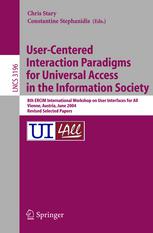

Most ebook files are in PDF format, so you can easily read them using various software such as Foxit Reader or directly on the Google Chrome browser.
Some ebook files are released by publishers in other formats such as .awz, .mobi, .epub, .fb2, etc. You may need to install specific software to read these formats on mobile/PC, such as Calibre.
Please read the tutorial at this link: https://ebookbell.com/faq
We offer FREE conversion to the popular formats you request; however, this may take some time. Therefore, right after payment, please email us, and we will try to provide the service as quickly as possible.
For some exceptional file formats or broken links (if any), please refrain from opening any disputes. Instead, email us first, and we will try to assist within a maximum of 6 hours.
EbookBell Team

4.8
24 reviewsThe 8th ERCIM Workshop “User Interfaces for All” was held in Vienna, Austria, on 28–29 June 2004, building upon the results of the seven previous workshops held in Heraklion, Crete, Greece, 30–31 October 1995; Prague, Czech Republic, 7–8 Nov- ber 1996; Obernai, France, 3–4 November 1997; Stockholm, Sweden, 19–21 October 1998; Dagstuhl, Germany, 28 November – 1 December 1999; Florence, Italy, 25–26 October 2000; and Paris (Chantilly), France, 24–25 October 2002. The concept of “User Interfaces for All” targets a proactive realization of the “- signforall”principleinthe?eldofhuman-computerinteraction(HCI),andinvolvesthe developmentof user interfaces to interactiveapplicationsand e-services, which provide universalaccess andusabilityto potentiallyall users. In thetraditionofits predecessors, the 8th ERCIM Workshop “User Interfaces for All” aimed to consolidate recent work and to stimulate further discussion on the state of the art in “User Interfaces for All” and its increasing range of applications in the upcoming Information Society. The emphasis of the 2004 event was on “User-Centered Interaction Paradigms for Universal Access in the Information Society. ” The requirement for user-centered u- versal access stems from the growing impact of the fusion of the emerging techno- gies and from the different dimensions of diversity that are intrinsic to the Information Society. These dimensions become evident when considering the broad range of user characteristics, the changing nature of human activities, the variety of contexts of use, the increasing availability and diversi?cation of information, knowledge sources and e-services, the proliferation of technological platforms, etc.